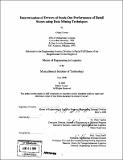| dc.contributor.advisor | Chris Caplice. | en_US |
| dc.contributor.author | Usman, Khalid, M. Eng. Massachusetts Institute of Technology. | en_US |
| dc.contributor.other | Massachusetts Institute of Technology. Engineering Systems Division. | en_US |
| dc.date.accessioned | 2009-04-29T17:14:26Z | |
| dc.date.available | 2009-04-29T17:14:26Z | |
| dc.date.copyright | 2008 | en_US |
| dc.date.issued | 2008 | en_US |
| dc.identifier.uri | http://hdl.handle.net/1721.1/45246 | |
| dc.description | Includes bibliographical references (leaves 66-67). | en_US |
| dc.description | Thesis (M. Eng. in Logistics)--Massachusetts Institute of Technology, Engineering Systems Division, 2008. | en_US |
| dc.description.abstract | This research applies data mining techniques to give a picture of the interaction of performance variables such as between stock-outs and store attributes, and stock-outs and other variables including store sales, income and demographic data, as well as various aspects of inventory management data. This research uses three data mining techniques: multiple ordinary-least-squares (OLS) regression, logistic regression and data clustering. The first part of the research evaluates how the effect of stock-outs at the distribution center (DC) level impacts the downstream sales at the store-level. Using multiple regression techniques, it was observed that stock-outs at the distribution center level have a detrimental impact on the sales at the retail store level. The second part of the project focuses on understanding the relationships of store stock-out performance to various drivers. The variables that were determined to be drivers of store performance include income level of the area, demographic profile, years the store has been in operation, day of the week delivery from distribution center, distance of store from the distribution center and average inventory-on-hand. Using data clustering techniques, worse performing and good performing clusters of stores were identified. The two worse performing clusters were 'Low-Income, Newer' stores and 'Newer, Further from DC' stores. The three good performing clusters were 'High-Income, High-Inventory' stores, 'Closer to DC, Older' Stores and 'High-Income, Smaller' stores. | en_US |
| dc.description.statementofresponsibility | by Khalid Usman. | en_US |
| dc.format.extent | 84 leaves | en_US |
| dc.language.iso | eng | en_US |
| dc.publisher | Massachusetts Institute of Technology | en_US |
| dc.rights | M.I.T. theses are protected by
copyright. They may be viewed from this source for any purpose, but
reproduction or distribution in any format is prohibited without written
permission. See provided URL for inquiries about permission. | en_US |
| dc.rights.uri | http://dspace.mit.edu/handle/1721.1/7582 | en_US |
| dc.subject | Engineering Systems Division. | en_US |
| dc.title | Determination of drivers of stock-out performance of retail stores using data mining techniques | en_US |
| dc.type | Thesis | en_US |
| dc.description.degree | M.Eng.in Logistics | en_US |
| dc.contributor.department | Massachusetts Institute of Technology. Engineering Systems Division | |
| dc.identifier.oclc | 310335536 | en_US |
